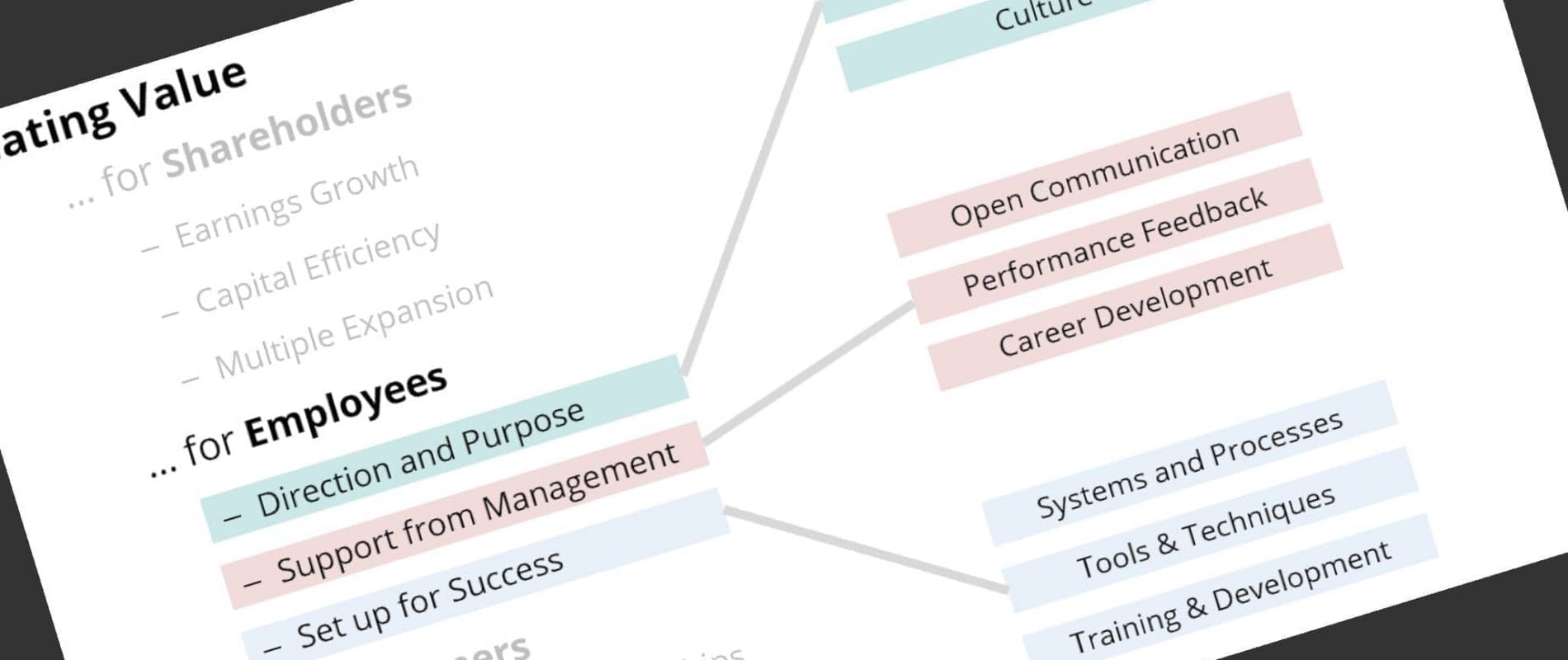Your digital transformation needs a compelling answer to a simple question: Why? This article talks about creating digital value by building a Great Company, with Employee Engagement as a guiding metric. (Part of a series of articles about Enterprise Value Creation for Digital Business.)
Your team can see the potential and promise of becoming a digital business – a transformational change that looks deeply into your daily operations, your customers and how you relate to them, and the products and services that you sell. Basically – what you make, how you sell, and how you deliver.
Digital methods and ideas hold a lot of promise, but they rarely appear in a vacuum. Other projects and initiatives are clamoring for your time – how do you make the prioritization decisions to start the journey? How do you effectively get the attention – and the commitment – of the folks on the shop floor, the people connecting with your customers, and the leadership team running the show?
The fundamental question is Why – as in, why is this the most impactful thing I could be working on? We have already laid out the overall framework for the different types of digital value creation, and in our last article, we drilled deeper into the most common ideas around creating financial value.
Great Stock vs. Great Company
Most business investment (time and money) goes to the work producing benefits that appear on the company’s financial statements. Increased profitability, better use of capital, reduction of risk – all traditional business benefit metrics that dominate most prioritization discussions. When the MBAs and the executives are in the board room, this gets boiled down to the overall goal of building a Great Stock – one that creates value for the owners (shareholders) and sustains that value over time.
But not all organizations hold this idea of value for the shareholders as the primary reason for their existence. There is more to life than working for that next buck – and such a single-minded purpose can be unsustainable over time. It is common to see other types of value highlighted in the primary objectives of the organization. Sometimes the focus is on the customer – understanding their needs in depth, and bringing joy and satisfaction with excellent products that solve real problems. Sometimes the focus is on the employees – the people that do the day-to-day work, connect with the customer, and create and service the products that you sell.
Focusing on your employees and your customers, and prioritizing the value that you create for them, is all about creating a Great Company – one that provides a great product, keeps their customers happy, and is a great place to work every day. This may not translate into the highest amount of profits – but it is the best way to build a company that will deliver value for a long time.
A focus on employees is easier to see with nonprofits and privately held companies – organizations where financial reporting is either not the point (nonprofit) or none of your business (private). To be fair, every organization has some form of financial reporting, but the degree to which those metrics dominate the decision making can vary.

Great Company, Part 1 – Employee Engagement
The first element of a Great Company is the people on the team. From the “top of the ladder” management team to the folks on the front lines – the people that come into direct contact with suppliers, partners, and (most importantly) your customers – there is an essential human element to every business.
Every day, these people come together, physically and virtually, to get the work done – and that simple idea can mean so many things. Modern organizations tend to lean out over time, spreading more work over fewer people. For these businesses, a high level of communication and shared understanding is critical for success. Related to this is the idea of community, feeling like you are part of a team; no amount of process will make up for a lack of open, honest communication about the why and how of everyday work.
In the past few years, the concept of Employee Engagement has become more prevalent in businesses that are looking to measure the ineffable quality of a team that “gets it”, and really “clicks” together. To some, Employee Engagement is a bit of a buzzword, and when first introduced to an organization, it can be a difficult concept to grasp. Fear not – Employee Engagement can be measured, in three simple areas:
- Direction and Purpose: Do I understand and believe in the purpose of the company – do I know where we are going?
- Support from Management: Do I get the help I need from my manager?
- Set Up for Success: Do I have the tools and processes needed to win every day?
Simple definitions, but challenging to measure. Of course, the most straightforward way is to just talk to your team; treat them like humans, with openness and honesty. This sounds simple – but it is not. You may be starting from a position of distrust (something to remedy!). Or it could just be logistically challenging to get face time with every single employee.
Let’s drill down to the next level, so we can understand what these conversations need to cover.
Direction and Purpose comes from …
- Mission / Vision: Does everyone on the team understand the core reason that the business exists? The problems we solve, and the benefits we bring to our customers?
- Values: Do we have a shared set of “operating rules”? Have these values been clearly defined? And are we practicing what we hold to be good?
- Culture: Are the norms of behavior well understood? And is the team finding the right mix of shared culture and diversity, and taking advantage of both?
Support from Management comes from …
- Open Communication: Is there genuinely open and honest communication coming from leaders and managers to the folks on the team?
- Performance Feedback: Do direct supervisors give regular, meaningful feedback (positive and negative constructive) on how the team is getting things done?
- Career Development: Are managers talking with their people about career plans, and working together to find opportunities for growth?
Set Up for Success comes from …
- Systems and Processes: Does the company actively look for better ways to get the job done?
- Tools and Techniques: Does the company invest in the right equipment – hardware, software, etc. – to optimize the work and the environment?
- Training and Development: Are people on the teams provided the opportunity to get ongoing training, learning new hard and soft skills to improve their performance and advance their careers?
Just like we did with shareholder value, we break down into smaller components to get better ideas on how to measure people’s feelings – and make an impact for the better.
Measurement and Meaning
Two critical thoughts always go through my mind when I talk with folks about employee engagement. The first has to do with measuring engagement – and it can seem complicated, as the concepts are more about feelings than quantifiable events or things. Many firms offer structured employee engagement surveys; if your company is large and complex, it may make sense to make this kind of investment.
At a minimum, it is all about communication – just start the conversation. Develop habits around frequent dialogue with the people on the team, pulling their opinions, observations, and suggestions out of them. There will be a bit of the Heisenberg effect here – by demonstrating your interest in Employee Engagement, you will increase engagement with many of the folks on your team!
Tying Employee Engagement to Digital Transformation
Your team is one of the five components of a great digital business. It makes sense that your focus on employee engagement will be central to your digital transformation. What are some examples of Digital Opportunities here?
- Operations: Conducting kaizen events to let people find process improvements in their regular tasks (systems and processes)
- Customers: Adding shop floor and back office representatives to customer visits and reviews (mission/vision)
- Products: Sponsoring “hackathon”-style sessions where employees experiment with digital tech to apply to customer challenges (training and development)
- Data: Add line employees to the teams designing operational metrics, figuring out new uses for the data gathered (performance feedback)
- Team: Invest in equipment, training, and time to implement video conferencing – and then iteratively work to introduce agile, collaborative process to change-averse groups (open and honest communication)
You may be surprised, but that last idea might be the toughest on the list. People get very comfortable with the ways that they interact with the world and each other, and change can sometimes be daunting.
So too can improvements in Employee Engagement – but the investment in time and thought will pay dividends in increased performance in other dimensions.
And besides – wouldn’t you prefer to work where people like what they were doing, believe in the mission, and are genuinely fun to be around?
Up Next: Value for the Customer
19 May, 2020






Comments (0)